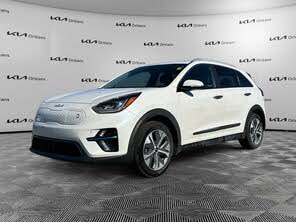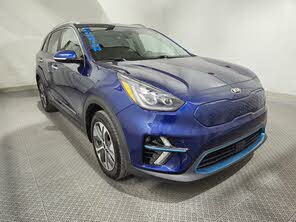Kia Niro EV vs Nissan LEAF
Overview | |
Years produced2011-Present | Years produced2019-Present |
MSRP$31,600 | MSRP$39,550 |
Average price$18,265 | Average price$31,378 |
Listings300 | Listings362 |
Ratings & Reviews | |
User Reviews | User Reviews |
Expert reviews | Expert reviews7.2 out of 10 |
Pros
| |
Reviews Summary | |
Reviews SummaryThe 2023 Kia Niro enters its second generation with fresh styling and numerous mechanical and tech updates, but it still offers a choice of three powertrains, with the Niro Hybrid, Niro EV, and Niro PHEV plug-in hybrid all returning for 2023. That means a change in focus for the all-electric Niro EV, which is the subject of this review. The first-generation Niro EV was Kia’s first mass-market electric car not based on an existing gasoline model (the Soul EV paved the way for it). But the redesigned 2023 Kia Niro EV now shares the lineup with the Kia EV6. That model takes aim at more premium electric vehicles like the Ford Mustang Mach-E, Hyundai IONIQ 5, and Nissan Ariya, leaving the Niro EV to compete with entry-level models, such as the Chevrolet Bolt EV and EUV, Volkswagen ID.4, and Nissan’s Leaf. For this review, we spent some time in the U.S. equivalent of the top Limited trim. | |
No video found | No video found |
Popular Features & Specs | |
Engine147 hp Electric | Engine201 hp Electric |
Drive TrainFWD | Drive TrainFWD |
Seating Capacity5 | Seating Capacity5 |
EV Battery Capacity40 kWh | EV Battery Capacity65 kWh |
MPG City123 | MPG City126 |
MPG Highway99 | MPG Highway101 |
Battery Charge Time (120V) | Battery Charge Time (120V)59 hours |
Battery Charge Time (240V)8 hours | Battery Charge Time (240V) |
Engine | |
Engine Name147 hp Electric | Engine Name201 hp Electric |
Battery Charge Time (120V) | Battery Charge Time (120V)59 hours |
Battery Charge Time (240V)8 hours | Battery Charge Time (240V) |
DrivetrainFWD | DrivetrainFWD |
Fuel Economy | |
EV Battery Capacity40 kWh | EV Battery Capacity65 kWh |
MPG City123 | MPG City126 |
MPG Highway99 | MPG Highway101 |
Interior | |
Seating Capacity5 | Seating Capacity5 |
Key Features | |
Navigation System | Navigation SystemStandard |
Safety | |
Front Crash Overall4 | Front Crash Overall |
Side Crash Overall5 | Side Crash Overall |
Dimensions & Capacity | |
Cargo Space23.6 cu ft | Cargo Space22.8 cu ft |
Curb Weight3538 lbs | Curb Weight3721 lbs |
Height61.4 in | Height61.8 in |
Length176.4 in | Length174.0 in |
Width70.5 in | Width71.8 in |
Wheelbase106.3 in | Wheelbase107.0 in |
Maximum Payload1220 lbs | Maximum Payload1063 lbs |
Number of doors4 | Number of doors4 |
Overview | ||
Years produced | 2011-Present | 2019-Present |
MSRP | $31,600 | $39,550 |
Average price | $18,265 | $31,378 |
Listings | ||
Ratings & Reviews | ||
User reviews | ||
Expert reviews | 7.2 out of 10Read full review | |
Pros & cons | Pros
| |
Summary | The 2023 Kia Niro enters its second generation with fresh styling and numerous mechanical and tech updates, but it still offers a choice of three powertrains, with the Niro Hybrid, Niro EV, and Niro PHEV plug-in hybrid all returning for 2023. That means a change in focus for the all-electric Niro EV, which is the subject of this review. The first-generation Niro EV was Kia’s first mass-market electric car not based on an existing gasoline model (the Soul EV paved the way for it). But the redesigned 2023 Kia Niro EV now shares the lineup with the Kia EV6. That model takes aim at more premium electric vehicles like the Ford Mustang Mach-E, Hyundai IONIQ 5, and Nissan Ariya, leaving the Niro EV to compete with entry-level models, such as the Chevrolet Bolt EV and EUV, Volkswagen ID.4, and Nissan’s Leaf. For this review, we spent some time in the U.S. equivalent of the top Limited trim. | |
Video | No video found | No video found |
Popular Features & Specs | ||
Engine | 147 hp Electric | 201 hp Electric |
Drive Train | FWD | FWD |
Seating Capacity | 5 | 5 |
EV Battery Capacity | 40 kWh | 65 kWh |
MPG City | 123 | 126 |
MPG Highway | 99 | 101 |
Battery Charge Time (120V) | 59 hours | |
Battery Charge Time (240V) | 8 hours | |
Engine | ||
Engine Name | 147 hp Electric | 201 hp Electric |
Battery Charge Time (120V) | 59 hours | |
Battery Charge Time (240V) | 8 hours | |
Drivetrain | FWD | FWD |
Fuel Economy | ||
EV Battery Capacity | 40 kWh | 65 kWh |
MPG City | 123 | 126 |
MPG Highway | 99 | 101 |
Interior | ||
Seating Capacity | 5 | 5 |
Key Features | ||
Navigation System | Standard | |
Safety | ||
Front Crash Overall | 4 | |
Side Crash Overall | 5 | |
Dimensions & Capacity | ||
Cargo Space | 23.6 cu ft | 22.8 cu ft |
Curb Weight | 3538 lbs | 3721 lbs |
Height | 61.4 in | 61.8 in |
Length | 176.4 in | 174.0 in |
Width | 70.5 in | 71.8 in |
Wheelbase | 106.3 in | 107.0 in |
Maximum Payload | 1220 lbs | 1063 lbs |
Number of doors | 4 | 4 |

By: CarGurus + AI
At CarGurus, our team of experienced automotive writers remain at the heart of our content operation, conducting hands-on car tests and writing insightful guides that are backed by years of industry experience. To complement this, we are harnessing AI to make our content offering more diverse and more helpful to shoppers than ever. To achieve this, our AI systems are based exclusively on CarGurus content, ratings and data, so that what we produce is both unique to CarGurus, and uniquely helpful to car shoppers.









































